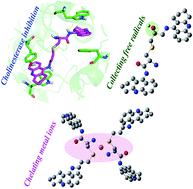Computational evidence to design an appropriate candidate for the treatment of Alzheimer's disease through replacement of the heptamethylene linker of bis(7)tacrine with S-allylcysteine†
Abstract
Due to the multiple pathogens of Alzheimer's disease, multitarget-directed ligand (MTDL) design has been highly regarded in recent years. MTDLs are used to control several pathogens at the same time. The main objective of this research is to provide an appropriate MTDL for the treatment of Alzheimer's disease. Due to the high importance of cholinesterase inhibition, chelating metal ions and collecting free radicals in the treatment of Alzheimer's disease, we used bis(7)tacrine as an efficient inhibitor of cholinesterase and S-allylcysteine as an excellent free radical scavenger and metal chelator. Accordingly, the heptamethylene linker of bis(7)tacrine was replaced with the structure of S-allylcysteine, leading to bis(7)tacrine-SAC. Performances of the designed ligand as a new potential multitarget-directed ligand (MTDL) have been theoretically studied. Antioxidant and chelating properties of bis(7)tacrine-SAC have been investigated using density functional theory (DFT). On the other hand, the ability of the proposed ligand to inhibit cholinesterase enzymes (AChE and BChE) has been examined by employing molecular dynamics simulations. The free energies for both enzymes in complexes with the designed ligand were also extracted. In this study we demonstrated that combination of bis(7)tacrine with S-allylcysteine presents a promising multitarget-directed ligand for the treatment of Alzheimer's disease. This ligand can not only inhibit the cholinesterase enzymes very well but also acts as an efficient antioxidant and metal scavenger. The results of quantum mechanics calculations, molecular docking, MD simulation and binding free energy calculations corroborate that bis(7)tacrine-SAC can simultaneously target some of the most important pathogens of Alzheimer's disease. In general, the obtained results show this ligand can be introduced as a worthwhile candidate for the treatment of Alzheimer's disease, although more accurate investigation using experimental methods is essential.


 Please wait while we load your content...
Please wait while we load your content...